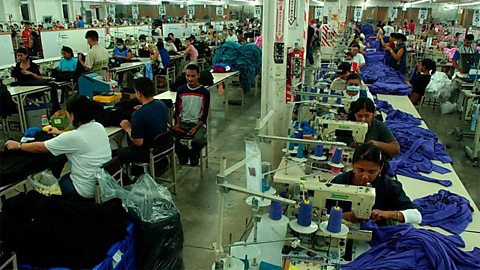What is globalisation?

Globalisation is the process by which the world is becoming increasingly interconnected as a result of massively increased trade and cultural exchange.
Globalisation has increased the production of goods and services. The biggest companies are no longer national firms but transnational or multinational corporations (MNC)Sometimes called transnational corporations (TNC). These are large and powerful businesses that sell products or services in different countries. with branches in many countries.
Globalisation has been taking place for hundreds of years, but has sped up enormously over the last half-century.
Globalisation has resulted in:
- increased international trade;
- a company operating in more than one country;
- greater dependence on the global economy;
- freer movement of capital, goods, and services;
- recognition of companies such as McDonalds and Starbucks in LEDCLess Economically Developed Country – usually a poorer country found in South America, Africa or Asia..
Although globalisationThis is the spread of industry across our world. New developments in transport, in technology, in developing communication links and the internet mean that businesses can sell globally rather than to just a small localised market. is probably helping to create more wealth in developing countries - it is not helping to close the gap between the world's poorest countries and the world's richest.
Most LEDCs continue to provide MEDCs with cheap labour and raw materials, and most of the wealth of the multinational companies goes back to the MEDC in which the company is based.
Also international laws are not always strictly enforced so multinationals can operate in LEDCs in a way that would not be allowed in an MEDC. They might pollute the environment, run risks with safety or pay low wages and have poor working conditions for their workers.
Reasons for globalisation
There are several key factors which have influenced the process of globalisation:
- Improvements in transportation - larger cargo ships mean that the cost of transporting goods between countries has decreased. economies of scaleThe cost advantages of operating on a larger scale, eg buying more cheaply in bulk and reducing unit costs. mean the cost per item can reduce when operating on a larger scale. Transport improvements also mean that goods and people can travel more quickly.
- Freedom of trade - organisations like the World Trade Organisation (WTO) promote free trade between countries, which help to remove barriers between countries.
- Improvements of communications - the internet and mobile technology have allowed greater communication between people in different countries.
- Labour availability and skills - countries such as India have lower labour costs (about a third of that of the UK) and also high skill levels. Labour intensive industries such as clothing can take advantage of cheaper labour costs and reduced legal restrictions in LEDCs.
How globalisation can help or hinder development
Globalisation is having a dramatic effect on world economies and on people's lives.
Positive impacts:
- inward investmentWhen a foreign company invests in a country, perhaps by building a factory or a shop. by Trans National Corporations (TNCs) helps countries by providing new jobs and skills for local people. TNCs bring wealth and foreign currency to local economies when they buy local resources, products and services. The extra money created by this investment can be spent on education, health and infrastructure.
- The sharing of ideas, experiences and lifestyles of people and cultures. People can experience foods and other products not previously available in their countries.
- Globalisation increases awareness of events in faraway parts of the world. For example, the UK was quickly made aware of the 2004 Indian Ocean tsunami and sent help rapidly in response.
- Globalisation may help to make people more aware of global issues such as deforestationThe cutting down of trees and forests to allow a different land use. and global warmingThe rise in the average temperature of the Earth's surface. and alert them to the need for sustainable developmentEconomic development which meets the needs of the current population without polluting the environment or depleting natural resources.. Critics of globalisation include groups such as environmentalistsPeople who work towards or advocate the protection of the environment from destruction and pollution., anti-poverty campaigners and trade unionistsWorkers who belong to an organised association that protects their interests when negotiating hours, wages and conditions..
Negative impacts:
- Globalisation operates mostly in the interests of the richest countries, which continue to dominate world trade at the expense of developing countries. The role of LEDCs in the world market is mostly to provide the North and West with cheap labour and raw materials.
- There are no guarantees that the wealth from inward investment will benefit the local community. Often, profits are sent back to the MEDCMore Economically Developed Country – usually a rich country found in Western Europe or North America. where the TNC is based. Transnational companies, with their massive economies of scale, may drive local companies out of business. If it becomes cheaper to operate in another country, the TNC might close down the factory and make local people redundant.
- An absence of strictly enforced international laws means that TNCs may operate in LEDCs in a way that would not be allowed in an MEDC. They may pollute the environment, run risks with safety or impose poor working conditions and low wages on local workers.
- Globalisation is viewed by many as a threat to the world's cultural diversity. It is feared it might drown out local economies, traditions and languages and simply re-cast the whole world in the mould of the capitalismAn economic system based on privately owned, as opposed to state-controlled, businesses and the creation of profit. North and West. An example of this is that a Hollywood film is far more likely to be successful worldwide than one made in India or China, which also have thriving film industries.
- Industry may begin to thrive in LEDCs at the expense of jobs in manufacturing in the UK and other MEDCs, especially in textiles.

Anti-globalisation campaigners sometimes try to draw people's attention to these points by demonstrating against the World Trade Organisation. The World Trade Organisation is an inter-government organisation that promotes the free flow of trade around the world.
Case study: India
Globalisation and India
India is a vast country with a population of 1.4 billion in 2024, nearly 18% of all the people on the planet. It is an emerging economic powerhouse. Its GDPGross Domestic Product – the total value of what is produced in a country. grew by 7.6% in the first part of 2024, much higher than other BRICSAn acronym of a group of countries (Brazil, Russia, India, China) experiencing fast economic growth. These countries have now been expanded. countries such as Russia and China, and also outstripping other large economies such as the USA and Japan.
India has changed entirely as a result of globalisation. It opened up its economy from the 1980s, removing barriers to trade and welcoming in entrepreneurs and foreign investors. As a result, it is now the fifth largest economy in the world in terms of GDP with particular strengths in agricultural production, information technology and manufacturing. Its economy continues to grow.
India is now a major country in global terms and is a key part of the G20, made up of the world’s largest economies. India continues to push for a permanent seat on the United Nations Security Council which has just five permanent members, another indication that is an increasingly powerful country in the world.
How has globalisation changed India?

Those who support globalisation argue that India’s rapid economic growth was due to it opening up its economy to the rest of the world. The growth has been helped by the huge domestic market, especially with an expanding middle class, alongside a young and technologically adept workforce. As a result, many companies have relocated there for manufacturing and for establishing call centres. There are also industries developed by local entrepreneurs, such as Infosys, ranked in the top three IT brands in the world.
Benefits and negatives of globalisation for India
Benefits of globalisation for India:
- India is now the largest exporter of Information Technology, with export revenues of US$194 billion in 2023, making up a quarter of all Indian exports.
- Bangalore, in southern India, has been called the Silicon Valley of India. Its technology industry started when Texas Instruments, a US IT multinational, established a factory there in 1985.
- Around 1.5 million people are now employed in these industries in Bangalore, mainly producing software for a wide range of uses such banking, telecommunications and internet applications.
- One factor helping its growth has been the number of young people in Bangalore who are highly skilled in science and engineering.
The benefits for the area in terms of income have been great but there have also been some downsides.
Negatives of globalisation for India
- Land prices have shot up so much that agriculture has declined.
- The demand for computer science and IT courses in colleges has risen and there is a shortage of people qualified in other areas.
There is still considerable poverty in India, despite its economic growth. The numbers of poor people have dropped, but one United Nations report suggested that there were still 80 million people in the country living on less than $1.25 per day in 2019. The same report found that 84% of the population lived on less than $6.85 per day.
The hope for those who welcome globalisation is that the wealth created will drive up living standards for everyone.
Watch: Globalisation video
How globalisation can help and hinder development.
Activity: Take the test
More on Contrasts in world development
Find out more by working through a topic
- count1 of 3
